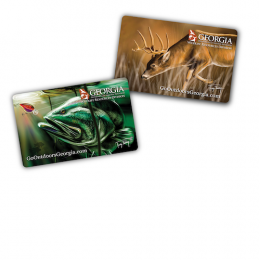
Black-throated green warbler (Terry W. Johnson)
By Terry W. Johnson
Recently while sitting outside talking with a friend, I noticed a tiny green larvae crawling up my shirt sleeve. The insect had fallen out of the pale green leaves of a nearby oak tree. The frail creature was a reminder that Nature is preparing a banquet for millions of northbound songbirds migrating back to their breeding grounds.
During the next several weeks, scores of different species of migratory songbirds such as warblers, vireos and thrushes will arrive in Georgia. Although some will stay and nest here, the vast majority will quickly resume their journey. Most of these birds make many stops to refuel and rest before finally arriving in the areas where they will nest. These places are called stopover areas, and if your yard is one, you will have the chance to see a kaleidoscope of colorful birds that otherwise would be rarely seen there.
Unfortunately, for those of us who enjoy backyard birding, the majority of these birds rarely visit our feeders. In fact, you have a better chance of attracting them to your birdbath than to feeders stocked with seed and suet. However, they can be drawn to your yard if you provide them with what they are seeking: the larvae of moths and butterflies – better known as caterpillars – in addition to other small arthropods and their larvae.
During migration, many songbirds rely on these animals to fuel their long flights. Remarkably, a pound of insects contains twice as much protein as a pound of beef. In addition, the organs of these critters are packed with fat.
Out of all of the arthropods found in your yard, the insects that are most valuable to these long-distance migrants are the caterpillars chomping away at leaves in the canopies of trees.
Just to give you some idea how important caterpillars are to spring migrants, let's take a quick look at the results of a research project conducted in Illinois. Researchers were trying to determine what migrating warblers were eating among the leaves of trees. They found that atop the trees in the study area, caterpillars comprised 75 to 98 percent of all of the insects present. These insects were so important to migrating warblers that the appearance of warblers occurred when there was an irruption of moth and butterfly caterpillars.
Other biologists have found that warblers and other songbirds fortunate enough to time their northward migration with these irruptions did not lose weight during migration. In fact, some birds actually gained weight under these conditions. However, migrants that had the misfortune of arriving at stopover locations when caterpillars were in short supply lost weight during their flights and arrived at their breeding grounds in poorer physical condition.
Other studies have demonstrated that migrants quickly leave stopover areas where caterpillars are scarce. The reason for this is that simply foraging for food causes the birds to use more energy than they are able to replenish.
On the other side of the coin, if caterpillars are abundant, songbirds are apt to linger and feed for three days or more before resuming their flights.
This means that for Georgia homeowners who want to have their yard serve as a spring stopover area need to have their property stocked with the native trees that host the most species of butterflies and moths – which translates to the most caterpillars. Notice that I did not simply say trees: Introduced ornamental trees produce 35 times less caterpillar biomass than native trees.
Here is a list of some of Georgia's native trees that host the most species of butterflies and moths: oaks (host 557 Lepidoptera species), cherries (456 species), willows (455), birches (411), poplars (567), crabapples (308), hickories (235), maples (297) and elms (215).
The number of caterpillars a bird can eat is astounding. A single warbler is capable of downing one to six caterpillars per minute. They are also eating spiders and the larva and adults of leafhoppers, scale insects and more.
Your yard may already be home to one or more of the trees mentioned. If not, and if you want to benefit migratory songbirds while at the same time increase the numbers bird species that stopover in your yard during spring, plant one or more of the tree species noted. Over time, these trees will provide the birds more food, and at less cost than a supplemental feeding program.
If your yard is already stocked with native trees, spend some time scanning their foliage from April into May. You may find you are already feeding more migratory songbirds than you ever imagined. If you are lucky, in a single day you may see a dozen or more species of warblers gleaning caterpillars and other larvae from the leaves of your trees.
Terry W. Johnson is a retired Nongame program manager with the Wildlife Resources Division and executive director of The Environmental Resources Network, or TERN, friends group of the division’s Nongame Conservation Section. (Permission is required to reprint this column.) Learn more about TERN, see previous “Out My Backdoor” columns, read Terry’s Backyard Wildlife Connection blog and check out his latest book, “A Journey of Discovery: Monroe County Outdoors.”




















